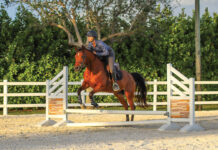Q: I plan to compete at the Beginner Novice level in eventing this year and hope to move up to Novice and Training. How fast should I go through the water crossing on a Beginner Novice course? My horse has foxhunting experience so he doesn’t fear water, but I don’t know how to handle water in a competition setting.
Imagine what happens when you run pell-mell into the ocean—you lose your balance, right? The same thing will happen to a horse that flies into water obstacles on course. Jumping cross-country water obstacles requires a carefully controlled, balanced canter that allows a horse to handle the terrain and footing changes he meets as he enters and exits the water.
Every cross-country jump requires confident, forward riding, even those you negotiate at a slower pace. As you approach the water crossing in competition, slow down to trot well ahead of the complex (about six to 10 strides before), so you can establish your trot and ride forward through the water. If you think your horse might question the water at all, you’re better off even walking a step or two into the water, so you can more easily stay behind your horse and encourage him forward. Then cluck and ask him to trot through the water, keeping a light contact on your reins so your horse stays organized as he navigates the obstacle.
Always keep your shoulders back, centered over your hips, as you ride through water at any pace, so you’ll keep your balance in case your horse bobbles in the water.
Don’t worry about incurring time faults here. Beginner Novice cross-country speeds are 300 to 350 meters per minute, which translates to a relaxed canter pace. Most horses easily achieve optimum time at this level even with some trotting on course. If needed, you can make up the time you spent crossing the water by moving on for a few strides during a non-jumping stretch of the course.
Once you’ve successfully trotted two or three Beginner Novice water crossings, ask your horse to canter through his next few complexes. Use the same riding technique, however, as you did in trot—slow down to an organized, balanced canter several strides away from the obstacle so you can canter confidently forward through the water.
Annie Eldridge is an event rider who trains out of her Setters’ Run Farm in Duxbury, Mass. and served as Horse Illustrated’s regular English Training Talk columnist.







good info